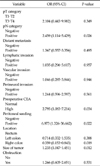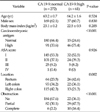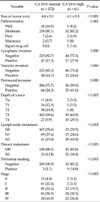Abstract
Purpose
Carcinoembryonic antigen (CEA) and carbohydrate antigen 19-9 (CA 19-9) are the most frequently used tumor markers in the clinical setting of colorectal cancer (CRC). This study was designed to investigate the correlation between preoperative serum levels of CA 19-9 (pre-CA 19-9) and the clinicopathologic factors of patients with CRC.
Methods
A study was performed on 333 patients with histologically diagnosed colorectal adenocarcinoma between December 2008 and November 2011, based on prospective collected data. The clinical data such as age, sex, location of tumor, size of tumor, differentiation, depth of tumor (T), lymph node metastasis (N), distant metastasis (M), lymphatic invasion, venous invasion, perineural invasion, stage, and preoperative serum levels of CEA (pre-CEA) and pre-CA 19-9 were obtained. These patients were classified into two groups according to pre-CA 19-9 (CA 19-9 high: >39 U/mL, n = 61 [18.3%]; CA 19-9 normal: <39 U/mL, n = 272 [81.7%]).
Results
Sixty-one patients among 333 patients (18.3%) with CRC showed a high pre-CA 19-9. The elevation of pre-CA 19-9 was significantly associated with size of tumor (4.8 ± 0.1 cm vs. 6.1 ± 0.3 cm, P < 0.001), right colon cancer (P < 0.001), depth of tumor (P < 0.001), lymph node metastasis (P < 0.001), distant metastasis (P < 0.001), perineural invasion (P = 0.008), peritoneal seeding (P < 0.001), and stage (P < 0.001). On multivariate analysis, high pre-CA 19-9 was shown to be independently associated with high pre-CEA, lymph node metastasis, right colon cancer, large tumor size, and peritoneal seeding. There were twelve patients confirmed for peritoneal seeding among 333 patients (3.6%).
Serum tumor markers such as carcinoembryonic antigen (CEA) and carbohydrate antigen 19-9 (CA 19-9) are commonly used in colorectal cancer (CRC) clinics. However, their clinical usefulness remains controversial from diagnostic, prognostic, and surveillance points of view [1]. The American Society of Clinical Oncology guidelines suggest that there is insufficient evidence for using CA 19-9 in the management of patients with CRC [2]. This study was designed to elucidate the efficiency of preoperative serum levels of CA 19-9 (pre-CA 19-9) as a tool for the preoperative diagnosis of CRC and to investigate the correlation between pre-CA 19-9 and the clinicopathologic factors of patients with CRC.
A total of 333 patients with histologically diagnosed colorectal adenocarcinoma were included in the study group between December, 2008 and November, 2011. Among them, 281 patients underwent curative resection and palliative resection was performed in 52 patients. Pre-CA 19-9 and preoperative serum levels of CEA (pre-CEA) were measured, with CEA >5.0 ng/mL and CA 19-9 >39 U/mL being regarded as elevated status. The clinical and pathological characteristics of patients with and without elevated pre-CA 19-9 were compared, as well as those with and without locally advanced cancer or peritoneal seeding. Locally advanced cancer included tumors that are T4N1-2Mx at the time of initial presentation. Peritoneal seeding was diagnosed when visible metastatic lesions had pathologic proof. Obstruction was classified on the basis of clinical endoscopic findings. The situation when endoscopy was not passed and preoperative bowel preparation was possible was regarded as partial obstruction. Complete obstruction was regarded as when flatus could not be passed, and preoperative bowel preparation was impossible. Statistical analysis was carried out using the SPSS ver. 12.0 (SPSS Inc., Chicago, IL, USA) by Clinical Trial Center, Department of Biostatistics. The clinicopathological variables between the groups were compared using Student t-tests or test for trend. The two groups were compared by cross-table analysis using Pearson's chi-square test. Logistic regression was applied for multivariate analysis to determine any important predictors of high pre-CA 19-9. P-value of less than 0.05 was considered to be statistically significant.
Sixty-one patients among 333 patients (18.3%) with CRC showed a high pre-CA 19-9. The Age, gender, body mass index, American Society of Anesthesiologists score did not differ significantly between patients with normal and high pre-CA 19-9. Patients with high pre-CA 19-9 were significantly more likely to show right side colon cancer and high CEA than patients with normal pre-CA 19-9 (Table 1).
Patients with high pre-CA 19-9 were significantly more likely to show perineural invasion, large tumor size, depth of tumor, lymph node metastasis, distant metastasis, and advanced tumor stage than patients with normal pre-CA 19-9. Differentiation, lymphatic invasion, vascular invasion did not differ significantly between patients with normal and high pre-CA 19-9 (Table 2).
The risk factors for pre-CA 19-9 based on multivariate analysis are shown in Table 3. High pre-CA 19-9 was shown to be independently associated with high pre-CEA (odds ratio [OR], 2.795; P = 0.034), lymph node metastasis (OR, 2.459; P = 0.026), right colon cancer (OR, 0.359; P = 0.019), large tumor size (OR, 1.233; P = 0.012), and peritoneal seeding (OR, 6.973; P = 0.022) in multivariate analysis.
There were twelve patients confirmed with peritoneal seeding among 333 patients (3.6%) (Table 4). Four patients with peritoneal seeding were not detected in preoperative radiologic evaluations and had high pre-CA 19-9. The sensitivity and specificity of preoperative serum CA 19-9 for peritoneal seeding were 75% and 83.8%, respectively. The positive predictive value and negative predictive value of preoperative serum CA 19-9 for peritoneal seeding were 14.8% and 85.2%, respectively (Table 5). The sensitivity and specificity of preoperative serum CEA for peritoneal seeding were 75.0% and 32.4%, respectively. The positive predictive value and negative predictive value of preoperative serum CEA for peritoneal seeding were 4.0% and 96.0%, respectively.
CA 19-9 is a predominant carbohydrate antigen that was defined from the culture medium of a CRC cell line [3]. Serum CEA and CA 19-9 are commonly used as classical tumor markers in CRC patients [4]. But Yamashita and Watanabe [1] suggested that pre-CEA and pre-CA 19-9 do not show satisfactory sensitivity as screening (diagnostic) markers in CRC. The utility of CA 19-9 as a diagnostic marker in colorectal cancer is limited in a number of ways. First, patients with negative Lewis blood group antigen cannot synthesize CA 19-9, and therefore it is not used as a serologic marker in these individuals, who make up about 10% of the population. Second, patients with benign biliary tract disease can have levels up to 400 U/mL, with 87% having concentrations higher than 70 U/mL. Significant numbers of patients with pancreatitis, either acute or chronic, also have elevated levels. Third, besides pancreatic cancer, CA 19-9 levels are also elevated in patients with other cancers, including those of the biliary tree (95%), stomach (5%), liver (hepatocellular carcinoma, 7%), and lung (13%). For CRC, CA 19-9 levels add little clinically useful information to determine CEA levels [5]. The low diagnostic power of CA 19-9 may be due to a high proportion of colorectal cancer patients having the Lewis (a-b-) phenotype, who cannot synthesize these markers [6]. The overall reported incidences of high pre-CA 19-9 range from 10.6% to 24.4% [7-11]. In our study, there were 61 patients (18.3%) with high pre-CA 19-9 among 333 patients. The American Society for Clinical Oncology recommends that the present data are insufficient to recommend CA 19-9 for screening, diagnosis, staging, surveillance, or monitoring treatment of patients with CRC [12].
Nevertheless, the clinical significance of pre-CA 19-9 is still controversial. Morita et al. [13] did not recommend routine use of CA 19-9 in staging and surveillance of CRC, because they could not find clinical significance to support the use of pre-CA 19-9 to predict the prognosis and detect recurrence of CRC [13]. In contrast, Nakagoe et al. [7] advocated that high pre-CA 19-9 may serve as a useful marker in identifying patients with node-negative CRC at high risk for recurrence after surgery [7]. The discrepancy is considered to be derived from the difference in size of the study and distribution of tumor stage in each study population. In another multivariate analysis showed tumor progression on chemotherapy (P < 0.0001), elevated preoperative serum CA 19-9 (P < 0.0001), number of resected metastases (P < 0.001), and the number of lines of chemotherapy (P < 0.04), but not the type of first line treatment, were independently associated with decreased survival [14]. We have concentrated on the significance of pre-CA 19-9 for CRC staging. In this study, high pre-CA 19-9 was shown to be independently associated with high pre-CEA, lymph node metastasis, right colon cancer, large tumor size, and peritoneal seeding.
It was interesting to find that high pre-CA 19-9 level was a predictive marker of peritoneal seeding before surgery. This kind of correlation between CA 19-9 and peritoneal seeding has been reported by some authors. Liu et al. [15] reported that depth of bowel wall invasion, lymph node metastasis, serum CEA level, and CA 19-9 level are risk factors for peritoneal metastasis in colorectal cancer. Yang et al. [10] suggested that CA 19-9 (>34.6 U/mL), pT4 and age (<59 years) were significant risk factors of positive peritoneal dissemination. Park et al. [8] reported postoperative serum CA 19-9 elevation was better related to peritoneal recurrence than to liver metastasis. Especially, Yang et al. [10] advocated that if the cutoff for CA 19-9 were set at 135 U/mL, the positive prediction rate for positive peritoneal dissemination from cytological study would reach 45%. Peritoneal metastasis is involved in approximately 10% to 15% of patients with colorectal cancer at time of initial presentation (synchronous metastasis) and in 20% to 50% of patients who develop recurrence (metachronous metastasis). In our study, there were twelve patients confirmed for peritoneal seeding among 333 patients (3.6%). Four patients with peritoneal seeding were not detected in preoperative radiologic evaluations and had high pre-CA 19-9. The extent pattern of hepatic or ovarian metastasis in these patients were 1 multiple hepatic metastasis, 1 single hepatic metastasis, 1 ovarian and adnexal metastasis. The peritoneal seeding patterns of this group were 2 isolated nodule and 2 localized seeding. The sensitivity and specificity of pre-CA 19-9 for peritoneal seeding were 75% and 83.8%. The positive predictive value and negative predictive value of pre-CA 19-9 for peritoneal seeding were 14.8% and 85.2%.
The mechanism of peritoneal seeding is generally accepted that most of the free tumor cells are sloughed from the primary tumor, but some might have come from other sources, for example, lymph nodes, ovary, or liver [10]. In our study, nine patients with obstruction (75%) had a peritoneal seeding (Table 4). But the risk of obstruction did not reach statistical significance on multivariate analysis for peritoneal seeding. Yang et al. [10] speculated that tumor invasion to peritoneal mesothelial cells might stimulate the expression of CA 19-9 with another possibility being that tumor cells with expression of CA 19-9 might have higher behavior ability of peritoneal metastasis pathway. Differentially expressed in tumor cells, CA 19-9 was a ganglioside-containing sialylated lacto-N-fucopentaose II (sialyl Lewis), structurally related to the Lewis blood group-related carbohydrate structure [16]. Metastases showed a stronger expression than primary tumors and when the tumors were divided according to stage, sialyl Lewis showed a lower expression in Dukes' A and B tumors than in more advanced stages [17]. These structures are of increasing interest since they may function as adhesion molecules; adhesion of tumor cells to the endothelial cell of blood vessels may be mediated by an interaction between sialyl Lewis and E-selectin [18] and tumor cell induced platelet aggregation [19]. Therefore, it was thought that the mechanism associated with colorectal cancer expressing pre-CA 19-9 might have a higher possibility of peritoneal seeding. High pre-CA 19-9 might be associated with advanced colorectal cancer including peritoneal recurrence and lung metastasis. Lin et al. [9] reported that CA 19-9 may be a prognostic factor for CRC patients with normal CEA levels and an aggressive follow-up protocol for lung metastasis should be used for these patients.
But this study had limitations in its results because the incidences of high pre-CA 19-9 were low (18.3%). Therefore, to make up for low incidence of pre-CA 19-9, the combination of data of pre-CA 19-9 and pre-CEA, as in Nozoe et al's [20] and Park et al's [8] study, should be more important in the future.
In conclusion, high pre-CA 19-9 level was shown to be independently associated with high pre-CEA, lymph node metastasis, right colon cancer, large tumor size, and peritoneal seeding of colorectal cancer. High pre-CA 19-9 might provide the important information needed to predict the subsequently possible peritoneal seeding of tumors not detected in radiologic examination and help the decision to treat patients of CRC. Patients with high pre-CA 19-9 should be warned of the possibility of peritoneal seeding and intraperitoneal chemotherapy. Longterm follow up including recurrence and survival rate should be required in order to provide prognostic information.
Figures and Tables
Table 3
The risk factors for preoperative serum carbohydrate antigen 19-9 based on multivariate analysis

Table 4
The characteristics of patients with peritoneal seeding

Pre-CEA, preoperative serum levels of carcinoembryonic antigen; Pre-CA 19-9, preoperative serum levels of carbohydrate antigen 19-9; T, tumor; N, node; M, metastasis; OP, operation; CT, computed tomography; PET, positron emission tomography; AR, anterior resection; LAR, low anterior resection; RHC, right hemicolectomy; TC, total colectomy; APR, abdominoperineal resection; SFC, splenic flexure colectomy.
Notes
References
1. Yamashita K, Watanabe M. Clinical significance of tumor markers and an emerging perspective on colorectal cancer. Cancer Sci. 2009. 100:195–199.
2. Bast RC Jr, Ravdin P, Hayes DF, Bates S, Fritsche H Jr, Jessup JM, et al. 2000 update of recommendations for the use of tumor markers in breast and colorectal cancer: clinical practice guidelines of the American Society of Clinical Oncology. J Clin Oncol. 2001. 19:1865–1878.
3. Goonetilleke KS, Siriwardena AK. Systematic review of carbohydrate antigen (CA 19-9) as a biochemical marker in the diagnosis of pancreatic cancer. Eur J Surg Oncol. 2007. 33:266–270.
4. Zheng CX, Zhan WH, Zhao JZ, Zheng D, Wang DP, He YL, et al. The prognostic value of preoperative serum levels of CEA, CA19-9 and CA72-4 in patients with colorectal cancer. World J Gastroenterol. 2001. 7:431–434.
5. Tan MC. Sabiston DC, Townsend CM, editors. Disorders of the anal canal. Sabiston textbook of surgery: the biological basis of modern surgical practice. 2007. 18th ed. Philadelphia: WB Saunders;761.
6. van der Schouw YT, Verbeek AL, Wobbes T, Segers MF, Thomas CM. Comparison of four serum tumour markers in the diagnosis of colorectal carcinoma. Br J Cancer. 1992. 66:148–154.
7. Nakagoe T, Sawai T, Tsuji T, Jibiki MA, Nanashima A, Yamaguchi H, et al. Preoperative serum level of CA19-9 predicts recurrence after curative surgery in node-negative colorectal cancer patients. Hepatogastroenterology. 2003. 50:696–699.
8. Park IJ, Choi GS, Jun SH. Prognostic value of serum tumor antigen CA19-9 after curative resection of colorectal cancer. Anticancer Res. 2009. 29:4303–4308.
9. Lin PC, Lin JK, Lin CC, Wang HS, Yang SH, Jiang JK, et al. Carbohydrate antigen 19-9 is a valuable prognostic factor in colorectal cancer patients with normal levels of carcinoembryonic antigen and may help predict lung metastasis. Int J Colorectal Dis. 2012. 27:1333–1338.
10. Yang SH, Lin JK, Lai CR, Chen CC, Li AF, Liang WY, et al. Risk factors for peritoneal dissemination of colorectal cancer. J Surg Oncol. 2004. 87:167–173.
11. Yakabe T, Nakafusa Y, Sumi K, Miyoshi A, Kitajima Y, Sato S, et al. Clinical significance of CEA and CA19-9 in postoperative follow-up of colorectal cancer. Ann Surg Oncol. 2010. 17:2349–2356.
12. Locker GY, Hamilton S, Harris J, Jessup JM, Kemeny N, Macdonald JS, et al. ASCO 2006 update of recommendations for the use of tumor markers in gastrointestinal cancer. J Clin Oncol. 2006. 24:5313–5327.
13. Morita S, Nomura T, Fukushima Y, Morimoto T, Hiraoka N, Shibata N. Does serum CA19-9 play a practical role in the management of patients with colorectal cancer? Dis Colon Rectum. 2004. 47:227–232.
14. Adam R, Pascal G, Castaing D, Azoulay D, Delvart V, Paule B, et al. Tumor progression while on chemotherapy: a contraindication to liver resection for multiple colorectal metastases? Ann Surg. 2004. 240:1052–1061.
15. Liu F, Yu J, Liang YZ, Hu YF, Wang YN, Li GX. Associated risk factors of peritoneal metastasis in colorectal cancer. Zhonghua Wei Chang Wai Ke Za Zhi. 2011. 14:254–256.
16. Koprowski H, Steplewski Z, Mitchell K, Herlyn M, Herlyn D, Fuhrer P. Colorectal carcinoma antigens detected by hybridoma antibodies. Somatic Cell Genet. 1979. 5:957–971.
17. Hoff SD, Matsushita Y, Ota DM, Cleary KR, Yamori T, Hakomori S, et al. Increased expression of sialyl-dimeric LeX antigen in liver metastases of human colorectal carcinoma. Cancer Res. 1989. 49(24 Pt 1):6883–6888.
18. Dabelsteen E. Cell surface carbohydrates as prognostic markers in human carcinomas. J Pathol. 1996. 179:358–369.
19. Martini F, Guadagni F, Lenti L, D'Alessandro R, Aloe S, Roselli M, et al. CA 19-9 monosialoganglioside content of human colorectal tumor cells correlates with tumor cell-induced platelet aggregation. Anticancer Res. 2000. 20(3A):1609–1614.
20. Nozoe T, Rikimaru T, Mori E, Okuyama T, Takahashi I. Increase in both CEA and CA19-9 in sera is an independent prognostic indicator in colorectal carcinoma. J Surg Oncol. 2006. 94:132–137.




 ePub
ePub Citation
Citation Print
Print





 XML Download
XML Download